HONDA PILOT 2016 3.G Quick Guide
Manufacturer: HONDA, Model Year: 2016, Model line: PILOT, Model: HONDA PILOT 2016 3.GPages: 89, PDF Size: 5.82 MB
Page 21 of 89
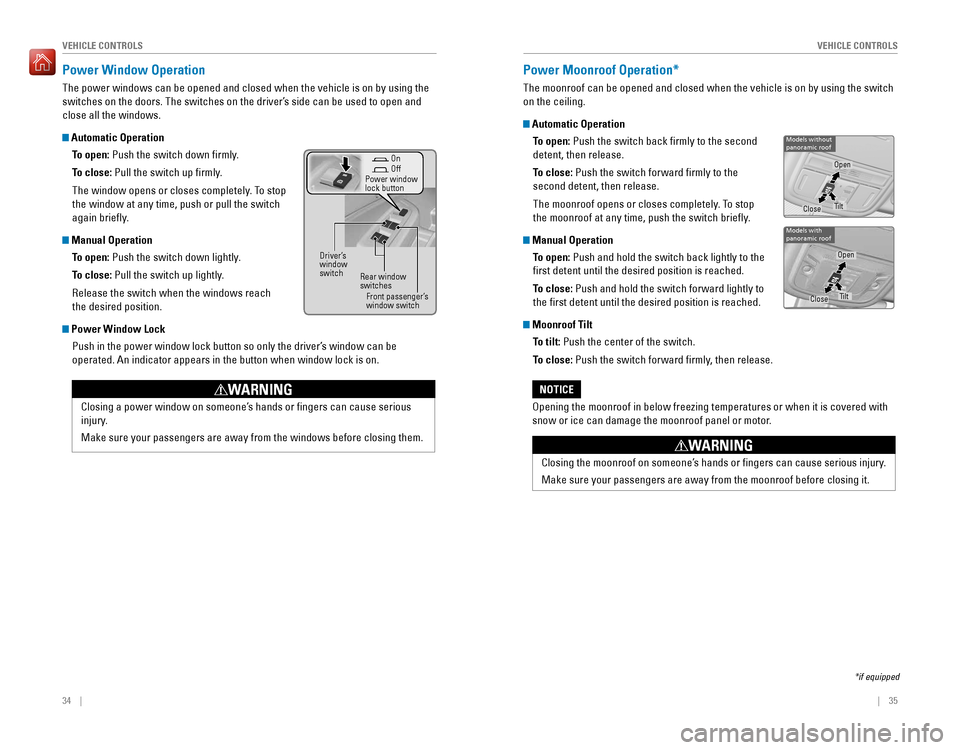
34 || 35
VEHICLE CONTROLSVEHICLE CONTROLS
Power Window Operation
The power windows can be opened and closed when the vehicle is on by usi\
ng the
switches on the doors. The switches on the driver’s side can be used to open and
close all the windows.
Automatic Operation
To open: Push the switch down firmly.
To close: Pull the switch up firmly.
The window opens or closes completely. To stop
the window at any time, push or pull the switch
again briefly.
Manual OperationTo open: Push the switch down lightly.
To close: Pull the switch up lightly.
Release the switch when the windows reach
the desired position.
Power Window LockPush in the power window lock button so only the driver’s window can be
operated. An indicator appears in the button when window lock is on.
Closing a power window on someone’s hands or fingers can cause serious
injury.
Make sure your passengers are away from the windows before closing them.
WARNING
OffPower window
lock button
Driver’s
window
switch Front passenger’s
window switchOn
Rear window
switches
Power Moonroof Operation*
The moonroof can be opened and closed when the vehicle is on by using th\
e switch
on the ceiling.
Automatic Operation To open: Push the switch back firmly to the second
detent, then release.
To close: Push the switch forward firmly to the
second detent, then release.
The moonroof opens or closes completely. To stop
the moonroof at any time, push the switch briefly.
Manual OperationTo open: Push and hold the switch back lightly to the
first detent until the desired position is reached.
To close: Push and hold the switch forward lightly to
the first detent until the desired position is reached.
Moonroof TiltTo tilt: Push the center of the switch.
To close: Push the switch forward firmly, then release.
Closing the moonroof on someone’s hands or fingers can cause serious injury.
Make sure your passengers are away from the moonroof before closing it.
WARNING
Opening the moonroof in below freezing temperatures or when it is covere\
d with
snow or ice can damage the moonroof panel or motor.
NOTICE
Models without
panoramic roof
Close
Open
Tilt
*if equipped
Models wit h
panoramic roof
Close
Open
Tilt
Page 22 of 89
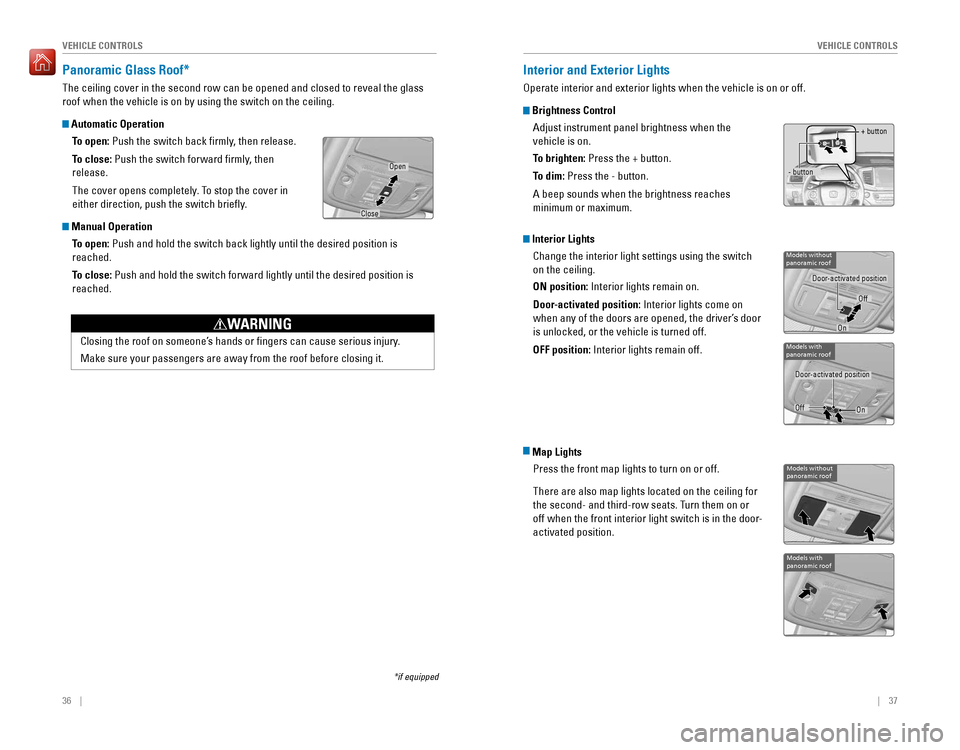
36 || 37
VEHICLE CONTROLSVEHICLE CONTROLS
Panoramic Glass Roof*
The ceiling cover in the second row can be opened and closed to reveal t\
he glass
roof when the vehicle is on by using the switch on the ceiling.
Automatic Operation
To open: Push the switch back firmly, then release.
To close: Push the switch forward firmly, then
release.
The cover opens completely. To stop the cover in
either direction, push the switch briefly.
Manual OperationTo open: Push and hold the switch back lightly until the desired position is
reached.
To close: Push and hold the switch forward lightly until the desired position is
reached.
Closing the roof on someone’s hands or fingers can cause serious injury.
Make sure your passengers are away from the roof before closing it.
WARNING
Close
Open
*if equipped
Interior and Exterior Lights
Operate interior and exterior lights when the vehicle is on or off.
Brightness ControlAdjust instrument panel brightness when the
vehicle is on.
To brighten: Press the + button.
To dim: Press the - button.
A beep sounds when the brightness reaches
minimum or maximum.
Interior LightsChange the interior light settings using the switch
on the ceiling.
ON position: Interior lights remain on.
Door-activated position: Interior lights come on
when any of the doors are opened, the driver’s door
is unlocked, or the vehicle is turned off.
OFF position: Interior lights remain off.
Map LightsPress the front map lights to turn on or off.
There are also map lights located on the ceiling for
the second- and third-row seats. Turn them on or
off when the front interior light switch is in the door-
activated position.
Models without
panoramic roof
On
Off
Door-activated position
Models without
panoramic roof
Models wit
h
panoramic roof
+ button
- button
Models with
panoramic roof
OnOff Door-activated position
Page 23 of 89
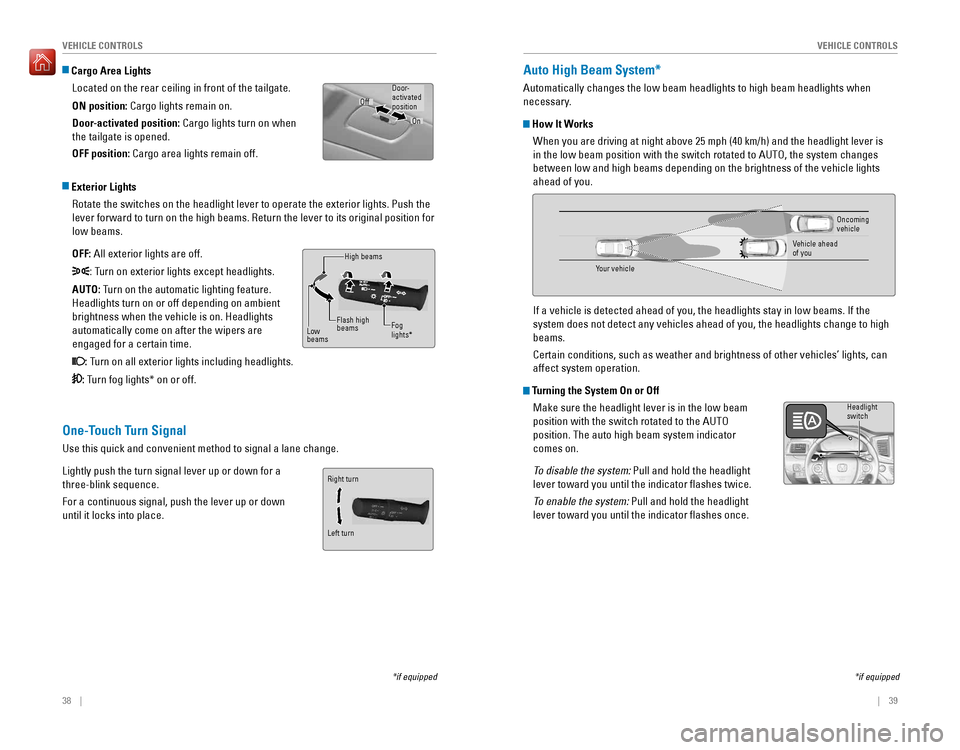
38 || 39
VEHICLE CONTROLSVEHICLE CONTROLS
Exterior Lights
Rotate the switches on the headlight lever to operate the exterior light\
s. Push the
lever forward to turn on the high beams. Return the lever to its origina\
l position for
low beams.
OFF: All exterior lights are off.
: Turn on exterior lights except headlights.
AUTO: Turn on the automatic lighting feature.
Headlights turn on or off depending on ambient
brightness when the vehicle is on. Headlights
automatically come on after the wipers are
engaged for a certain time.
: Turn on all exterior lights including headlights.
: Turn fog lights* on or off.
Cargo Area LightsLocated on the rear ceiling in front of the tailgate.
ON position: Cargo lights remain on.
Door-activated position: Cargo lights turn on when
the tailgate is opened.
OFF position: Cargo area lights remain off.
On
Off
*if equipped
High beams
Low
beams Flash high
beams
Fog
lights*
One-Touch Turn Signal
Use this quick and convenient method to signal a lane change.
Lightly push the turn signal lever up or down for a
three-blink sequence.
For a continuous signal, push the lever up or down
until it locks into place.
Left turn
Right turn
Auto High Beam System*
Automatically changes the low beam headlights to high beam headlights wh\
en
necessary.
How It Works
When you are driving at night above 25 mph (40 km/h) and the headlight\
lever is
in the low beam position with the switch rotated to AUTO, the system cha\
nges
between low and high beams depending on the brightness of the vehicle li\
ghts
ahead of you.
If a vehicle is detected ahead of you, the headlights stay in low beams.\
If the
system does not detect any vehicles ahead of you, the headlights change \
to high
beams.
Certain conditions, such as weather and brightness of other vehicles’\
lights, can
affect system operation.
Turning the System On or OffMake sure the headlight lever is in the low beam
position with the switch rotated to the AUTO
position. The auto high beam system indicator
comes on.
To disable the system: Pull and hold the headlight
lever toward you until the indicator flashes twice.
To enable the system: Pull and hold the headlight
lever toward you until the indicator flashes once.
Your vehicle
Headlight switch
*if equipped
Oncoming
vehicle
Vehicle ahead
of you
Door-
activated
position
Page 24 of 89
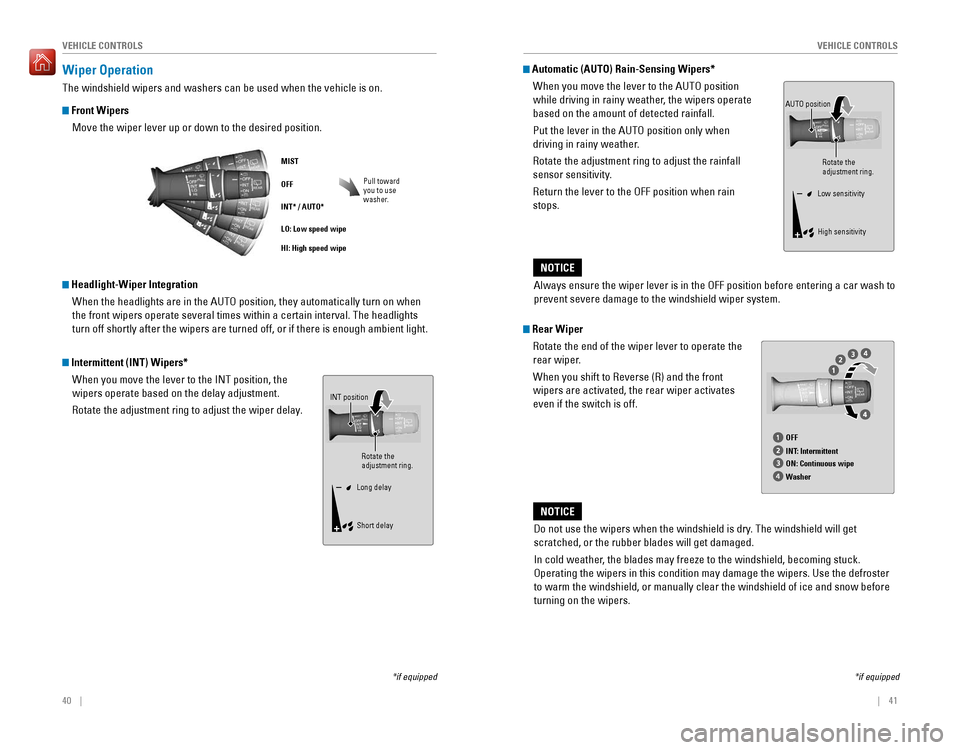
40 || 41
VEHICLE CONTROLSVEHICLE CONTROLS
Wiper Operation
The windshield wipers and washers can be used when the vehicle is on.
Front Wipers
Move the wiper lever up or down to the desired position.
Pull toward you to use
washer.
MIST
OFF
INT* / AUTO*
LO: Low speed wipe
HI: High speed wipe
*if equipped
Always ensure the wiper lever is in the OFF position before entering a c\
ar wash to
prevent severe damage to the windshield wiper system.
NOTICE
Do not use the wipers when the windshield is dry. The windshield will get
scratched, or the rubber blades will get damaged.
In cold weather, the blades may freeze to the windshield, becoming stuck.
Operating the wipers in this condition may damage the wipers. Use the de\
froster
to warm the windshield, or manually clear the windshield of ice and snow before
turning on the wipers.
NOTICE
Rear Wiper Rotate the end of the wiper lever to operate the
rear wiper.
When you shift to Reverse (R) and the front
wipers are activated, the rear wiper activates
even if the switch is off.
INT: Intermittent
OFF
Washer ON: Continuous wipe
Intermittent (INT) Wipers*When you move the lever to the INT position, the
wipers operate based on the delay adjustment.
Rotate the adjustment ring to adjust the wiper delay.
Headlight-Wiper IntegrationWhen the headlights are in the AUTO position, they automatically turn on\
when
the front wipers operate several times within a certain interval. The he\
adlights
turn off shortly after the wipers are turned off, or if there is enough \
ambient light.
Automatic (AUTO) Rain-Sensing Wipers*When you move the lever to the AUTO position
while driving in rainy weather, the wipers operate
based on the amount of detected rainfall.
Put the lever in the AUTO position only when
driving in rainy weather.
Rotate the adjustment ring to adjust the rainfall
sensor sensitivity.
Return the lever to the OFF position when rain
stops.
Rotate the adjustment ring.
Long delay
Short delay
INT position
Rotate the adjustment ring.
Low sensitivity
High sensitivity
AUTO position
*if equipped
Page 25 of 89
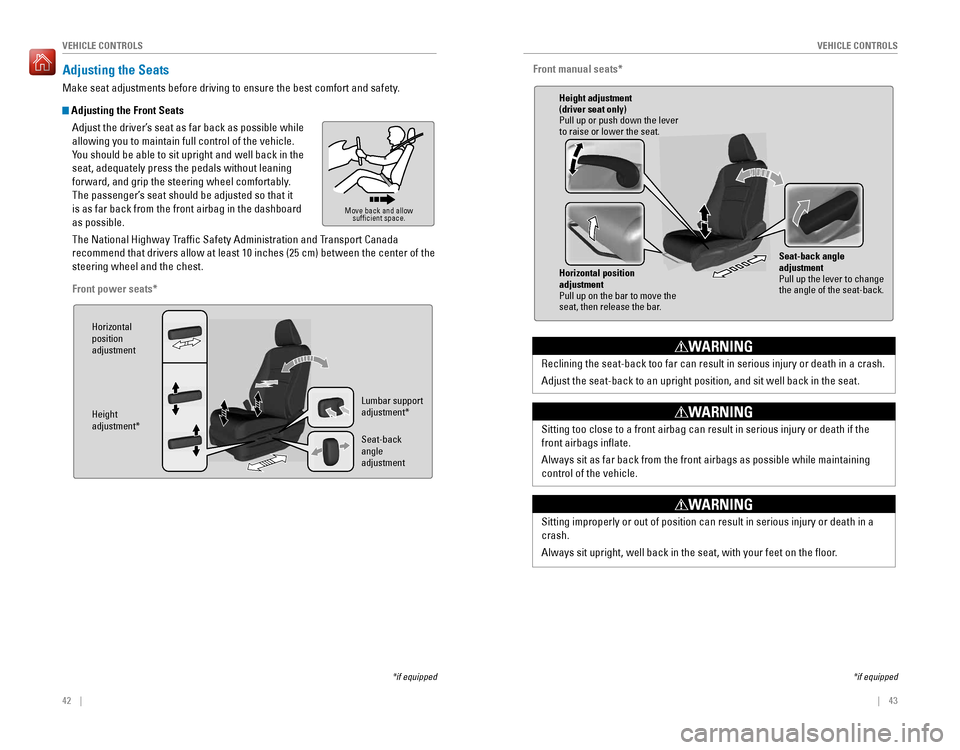
42 || 43
VEHICLE CONTROLSVEHICLE CONTROLS
Adjusting the Seats
Make seat adjustments before driving to ensure the best comfort and safe\
ty.
Adjusting the Front Seats
Adjust the driver’s seat as far back as possible while
allowing you to maintain full control of the vehicle.
You should be able to sit upright and well back in the
seat, adequately press the pedals without leaning
forward, and grip the steering wheel comfortably.
The passenger’s seat should be adjusted so that it
is as far back from the front airbag in the dashboard
as possible.
The National Highway Traffic Safety Administration and Transport Canada
recommend that drivers allow at least 10 inches (25 cm) between the ce\
nter of the
steering wheel and the chest.
Front power seats*
Move back and allow sufficient space.
Horizontal
position
adjustment
Height
adjustment* Lumbar support
adjustment*
Seat-back
angle
adjustment
*if equipped
Sitting improperly or out of position can result in serious injury or de\
ath in a
crash.
Always sit upright, well back in the seat, with your feet on the floor\
.
WARNING
Front manual seats*
Horizontal position
adjustment
Pull up on the bar to move the
seat, then release the bar.
*if equipped
Reclining the seat-back too far can result in serious injury or death in\
a crash.
Adjust the seat-back to an upright position, and sit well back in the se\
at.
WARNING
Sitting too close to a front airbag can result in serious injury or deat\
h if the
front airbags inflate.
Always sit as far back from the front airbags as possible while maintain\
ing
control of the vehicle.
WARNING
Height adjustment
(driver seat only)
Pull up or push down the lever
to raise or lower the seat.
Seat-back angle
adjustment
Pull up the lever to change
the angle of the seat-back.
Page 26 of 89
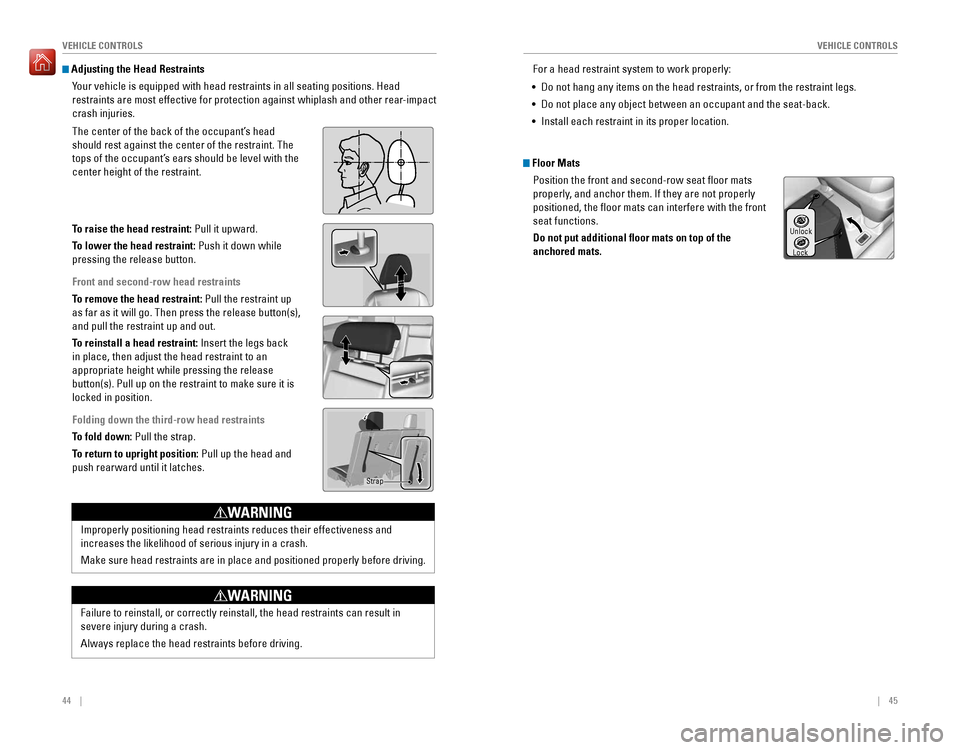
44 || 45
VEHICLE CONTROLSVEHICLE CONTROLS
Adjusting the Head Restraints
Your vehicle is equipped with head restraints in all seating positions. H\
ead
restraints are most effective for protection against whiplash and other \
rear-impact
crash injuries.
The center of the back of the occupant’s head
should rest against the center of the restraint. The
tops of the occupant’s ears should be level with the
center height of the restraint.
To raise the head restraint: Pull it upward.
To lower the head restraint: Push it down while
pressing the release button.
Front and second-row head restraints
To remove the head restraint: Pull the restraint up
as far as it will go. Then press the release button(s),
and pull the restraint up and out.
To reinstall a head restraint: Insert the legs back
in place, then adjust the head restraint to an
appropriate height while pressing the release
button(s). Pull up on the restraint to make sure it is
locked in position.
Folding down the third-row head restraints
To fold down: Pull the strap.
To return to upright position: Pull up the head and
push rearward until it latches.
Position head in the
center of the head
restraint.
Improperly positioning head restraints reduces their effectiveness and
increases the likelihood of serious injury in a crash.
Make sure head restraints are in place and positioned properly before dr\
iving.
WARNING
Failure to reinstall, or correctly reinstall, the head restraints can re\
sult in
severe injury during a crash.
Always replace the head restraints before driving.
WARNING
Strap
Floor MatsPosition the front and second-row seat floor mats
properly, and anchor them. If they are not properly
positioned, the floor mats can interfere with the front
seat functions.
Do not put additional floor mats on top of the
anchored mats.
Unlock
Lock
For a head restraint system to work properly:
• Do not hang any items on the head restraints, or from the restraint legs\
.
• Do not place any object between an occupant and the seat-back.
• Install each restraint in its proper location.
Page 27 of 89

46 || 47
VEHICLE CONTROLSVEHICLE CONTROLS
Seat-back angle adjustmentPull up the lever to change
the angle.
Horizontal position adjustment
Pull up the bar to move the seat,
then release the bar.
Rear Seats
Adjust second-row seats, access third-row seats, or fold down seats for carrying
cargo.
Adjusting the Second-Row Passenger’s Seats
Folding Down the Second-Row Seat
Separately fold down the left and right halves of the second-row seat to\
make
room for cargo.
1. Store the center seat belt first. Insert the latch
plate into the slot on the side of the anchor
buckle.
2. Retract the seat belt into the holder on the ceiling
(see page 8).
3. Lower the center head restraint to its lowest
position. Put the armrest back into the seat-back.
4. Pull up on the seat-back angle adjustment lever.
To return the seat to the original position, pull up the seat-back in the\
upright
position.
Lever
Adjusting the Third-Row Passenger’s Seats
Seat-back angle adjustmentPull the strap to change the
angle.
Third-Row Seat Access Using the button*
Press the button on the seat-back or seat cushion
when the vehicle is stopped. The whole seat slides
forward.
Using the lever or strap*
Pull up on the lever or strap. The whole seat slides
forward.
Strap
*if equipped
Page 28 of 89
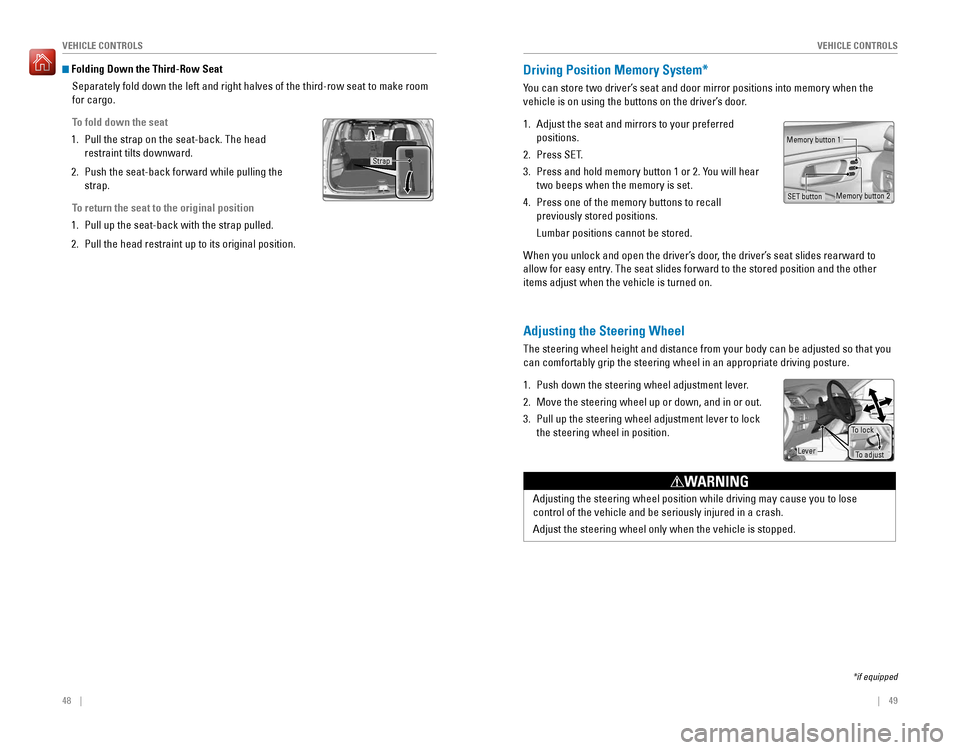
48 || 49
VEHICLE CONTROLSVEHICLE CONTROLS
Folding Down the Third-Row Seat
Separately fold down the left and right halves of the third-row seat to \
make room
for cargo.
To fold down the seat
1. Pull the strap on the seat-back. The head
restraint tilts downward.
2. Push the seat-back forward while pulling the
strap.
To return the seat to the original position
1. Pull up the seat-back with the strap pulled.
2. Pull the head restraint up to its original position.
Strap
Adjusting the Steering Wheel
The steering wheel height and distance from your body can be adjusted so\
that you
can comfortably grip the steering wheel in an appropriate driving postur\
e.
1. Push down the steering wheel adjustment lever.
2. Move the steering wheel up or down, and in or out.
3. Pull up the steering wheel adjustment lever to lock
the steering wheel in position.
Adjusting the steering wheel position while driving may cause you to los\
e
control of the vehicle and be seriously injured in a crash.
Adjust the steering wheel only when the vehicle is stopped.
WARNING
To adjust
To lock
Lever
Driving Position Memory System*
You can store two driver’s seat and door mirror positions into memory when the
vehicle is on using the buttons on the driver’s door.
1. Adjust the seat and mirrors to your preferred
positions.
2. Press SET.
3. Press and hold memory button 1 or 2. You will hear
two beeps when the memory is set.
4. Press one of the memory buttons to recall
previously stored positions.
Lumbar positions cannot be stored.
When you unlock and open the driver’s door, the driver’s seat slides rearward to
allow for easy entry. The seat slides forward to the stored position and the other
items adjust when the vehicle is turned on.
Memory button 1
SET button
*if equipped
Memory button 2
Page 29 of 89
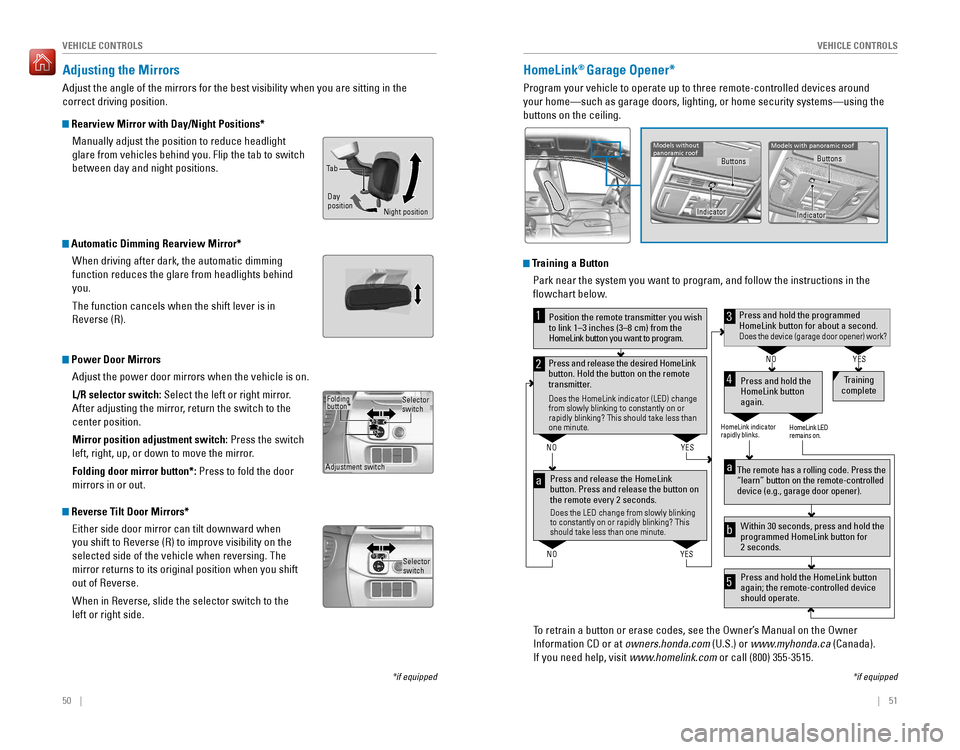
50 || 51
VEHICLE CONTROLSVEHICLE CONTROLS
*if equipped
Adjusting the Mirrors
Adjust the angle of the mirrors for the best visibility when you are sit\
ting in the
correct driving position.
Rearview Mirror with Day/Night Positions*
Manually adjust the position to reduce headlight
glare from vehicles behind you. Flip the tab to switch
between day and night positions.
Automatic Dimming Rearview Mirror*When driving after dark, the automatic dimming
function reduces the glare from headlights behind
you.
The function cancels when the shift lever is in
Reverse (R).
Power Door MirrorsAdjust the power door mirrors when the vehicle is on.
L/R selector switch: Select the left or right mirror.
After adjusting the mirror, return the switch to the
center position.
Mirror position adjustment switch: Press the switch
left, right, up, or down to move the mirror.
Folding door mirror button*: Press to fold the door
mirrors in or out.
Reverse Tilt Door Mirrors*Either side door mirror can tilt downward when
you shift to Reverse (R) to improve visibility on the
selected side of the vehicle when reversing. The
mirror returns to its original position when you shift
out of Reverse.
When in Reverse, slide the selector switch to the
left or right side.
Night position
Ta b
Day
position
Folding button*
Adjustment switch Selector
switch
Selectorswitch
Models without
panoramic roof
HomeLink® Garage Opener*
Program your vehicle to operate up to three remote-controlled devices ar\
ound
your home—such as garage doors, lighting, or home security systems—\
using the
buttons on the ceiling.
Training a Button
Park near the system you want to program, and follow the instructions in\
the
flowchart below.
To retrain a button or erase codes, see the Owner’s Manual on the Owner
Information CD or at owners.honda.com (U.S.) or www.myhonda.ca (Canada).
If you need help, visit www.homelink.com or call (800) 355-3515.
Press and release the HomeLink
button. Press and release the button on
the remote every 2 seconds.
Does the LED change from slowly blinking
to constantly on or rapidly blinking? This
should take less than one minute.
Press and hold the
HomeLink button
again. Training
complete
YES
NO
HomeLink indicator
rapidly blinks. HomeLink LED
remains on.
YES
NO
YES
NO
Position the remote transmitter you wish
to link 1–3 inches (3–8 cm) from the
HomeLink button you want to program.1
Press and release the desired HomeLink
button. Hold the button on the remote
transmitter.
Does the HomeLink indicator (LED) change
from slowly blinking to constantly on or
rapidly blinking? This should take less than
one minute.
2
aThe remote has a rolling code. Press the
“learn” button on the remote-controlled
device (e.g., garage door opener) .
Press and hold the HomeLink button
again; the remote-controlled device
should operate. Within 30 seconds, press and hold the
programmed HomeLink button for
2 seconds.a
Press and hold the programmed HomeLink button for about a second.Does the device (garage door opener) work?
3
b
4
5
*if equipped
Indicator
Models with panoramic roof
Buttons
Indicator
Buttons
Page 30 of 89

52 || 53
VEHICLE CONTROLSVEHICLE CONTROLS
Air Conditioning System*
Manually control the front and rear heating and cooling in your vehicle’\
s interior
using the buttons on the dashboard.
Front Operation
Fan control switch
A/C
buttonMAX A/C
button Windshield
defroster
buttonTemperature
control
switch
RR SETTINGS
button: Adjust
rear temperature. Temperature
control switch
Recirculation button:
Recirculation mode
(indicator on):
Recirculates air from the
vehicle’s interior.
Fresh air mode
(indicator off): Maintains
outside ventilation.
Rear
defogger/
heated door
mirrors
button*
Fan control
switch ON/OFF
button
REAR ON/OFF
button
MODE
button
MODE button:
Change airflow
location.
*if equipped
Rear Operation
Climate Control System*
The automatic climate control system can maintain your preferred interio\
r
temperature by selecting the proper mix of heated or cooled air and fan \
speed. Use
the buttons on the dashboard to control both front and rear operation.
Climate control is turned off during auto idle stop operation* (see pag\
e 112).
Front Operation
AUTO button: Press, then
use the temperature
control switch to set your
preferred temperature. SYNC button: Set the passenger’s
side and rear temperature to the
same as the driver’s side.
Driver’s
side
temperature
control
switch
A/C
buttonPassenger’s
side
temperature
control
switch
Recirculation button:
Recirculation mode (indicator on):
Recirculates air from the vehicle’s interior.
Fresh Air mode (indicator off): Maintains
outside ventilation.
Rear
defogger/
heated door
mirrors
button*
Windshield
defroster
button
Fan
control
buttons
ON/OFF
buttonMODE button:
Change airflow
location.
*if equipped
Rear Operation
REAR LOCK button:
Disable rear control.
RR SETTINGS button:
Adjust rear temperature.
REAR ON/OFF
button